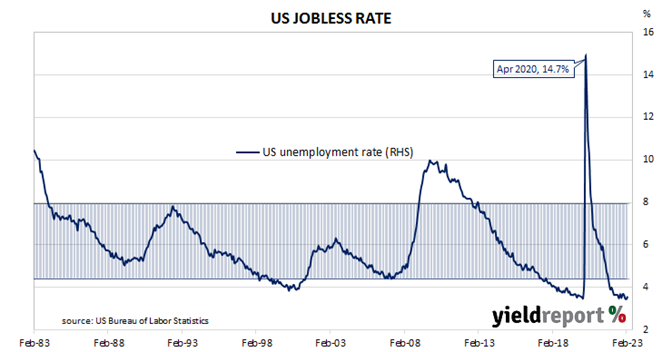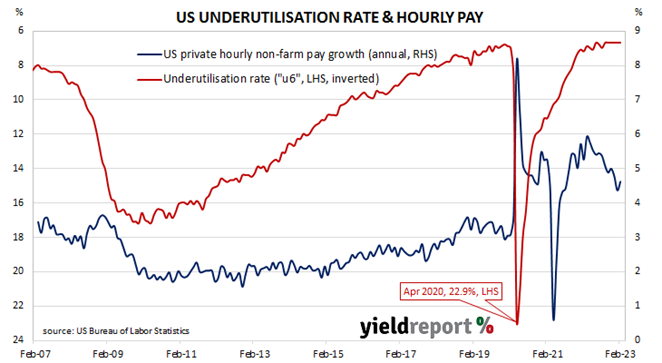Summary: Non-farm payrolls up 311,000 in February, greater than expected; previous two months’ figures revised down by 34,000; jobless rate up from 3.4% to 3.6%, participation rate up; figures “justify another 50bps hike”; employed-to-population ratio steady; underutilisation rate up from 6.6% to 6.8%; annual hourly pay growth up from 4.4% to 4.6%.
The US economy ceased producing jobs in net terms as infection controls began to be implemented in March 2020. The unemployment rate had been around 3.5% but that changed as job losses began to surge through March and April of 2020. The May 2020 non-farm employment report represented a turning point and subsequent months provided substantial employment gains. Changes in recent months have been generally more modest but still above the average of the last decade.
According to the US Bureau of Labor Statistics, the US economy created an additional 311,000 jobs in the non-farm sector in February. The increase was greater than the 215,000 which had been generally expected but considerably less than the 504,000 jobs which had been added in January after revisions. Employment figures for December and January were revised down by a total of 34,000.
The total number of unemployed increased by 242,000 to 5.936 million while the total number of people who were either employed or looking for work increased by 419,000 to 166.251 million. These changes led to the US unemployment rate declining from January’s revised figure of 3.4% to 3.6% as the participation rate ticked up from 62.4% to 62.5%.
“There was enough strength in the report to justify another 50bps hike…given average hourly earnings for production and non-supervisory workers was stronger at 0.46% after being 0.30% in January,” noted NAB Head of Market Economics (Markets), Tapas Strickland.
US Treasury yields fell significantly on the day, although the movement was largely driven by a general flight to low-risk assets following the insolvency of Silicon Valley Bank. By the close of business, the 2-year yield had shed 29bps to 4.59%, the 10-year yield had lost 22bps to 3.70% while the 30-year yield finished 16bps lower at 3.71%.
In terms of US Fed policy, expectations of higher federal funds rates over the next 12 months softened materially. At the close of business, contracts implied the effective federal funds rate would average 4.6625% in March, 9bps higher than the current spot rate, and then climb to an average of 4.90% in April. May futures contracts implied a 5.145% average effective federal funds rate while February 2024 contracts implied 4.70%.
One figure which is indicative of the “spare capacity” of the US employment market is the employment-to-population ratio. This ratio is simply the number of people in work divided by the total US population. It hit a cyclical-low of 58.2 in October 2010 before slowly recovering to just above 61% in late-2019. February’s reading remained steady at 60.2%, still some way from the April 2000 peak reading of 64.7%.
Apart from the unemployment rate, another measure of tightness in the labour market is the underutilisation rate and the latest reading of it registered 6.8%, up from 6.6% in January. Wage inflation and the underutilisation rate usually have an inverse relationship, even though hourly pay growth in the year to February accelerated from 4.4% to 4.6%.
“Moderation in wage growth is encouraging for the Fed, but the numbers could be biased by strong growth in leisure and hospitality jobs, which are lower paid than average,” Steven noted.



